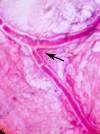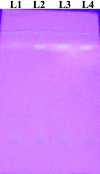Keratitis due to Aspergillus flavus: clinical profile, molecular identification of fungal strains and detection of aflatoxin production
- PMID: 20461152
- PMCID: PMC2866576
Keratitis due to Aspergillus flavus: clinical profile, molecular identification of fungal strains and detection of aflatoxin production
Abstract
Purpose: To document the clinical profile of patients with keratitis due to Aspergillus flavus and to elaborate on differences in the aflatoxin-producing potential of keratitis strains versus environmental strains of A. flavus.
Methods: Over a 6-month period, strains of Aspergillus flavus were isolated in culture from corneal scrape or biopsy material of patients who presented with suppurative keratitis (clinical isolates). The strains were confirmed to be A. flavus by molecular methods (amplification of the internal transcribed spacer 2 [ITS 2] region and direct sequencing followed by comparative GenBank analysis). The aflatoxin-producing potential of each strain was determined by thin-layer chromatography. The ability of each strain to form sclerotia in Czapek-Dox agar (CDA) after 7 days incubation at 30 degrees C in the dark and to produce a beige ring in yeast extract sucrose agar supplemented with methyl beta-cyclodextrin and sodium desoxycholate (YESD medium) after 3 days incubation at 30 degrees C was also assessed. For comparison, the tests were also run on 10 strains of A. flavus (identity confirmed by molecular methods) collected from local farming areas (environmental isolates).
Results: Aflatoxin B1 was detected in 16 (80%) of 20 culture filtrate or mycelial homogenate samples of the clinical isolates (mean concentration: 366.7+/-125.4 parts per billion [ppb]) but in only eight (40%) of 20 samples of environmental isolates (mean concentration: 306.6+/-125.4 ppb). Seven of the eight aflatoxin-producing clinical isolates and two of the four aflatoxin-producing environmental isolates formed sclerotia (>400 microm) and a beige ring in culture.
Conclusions: Aflatoxin B1 was detected in a significantly higher percentage of growth samples of clinical isolates (80%) than growth samples of environmental isolates (40%) (chi(2)=6.667; p=0.0098); the therapeutic implications of this finding require further study. The production of sclerotia and a beige ring in culture appear to be useful markers of aflatoxin-producing potential in strains of A. flavus isolated from keratitis.
Figures





Similar articles
-
Expression of genes of the aflatoxin biosynthetic pathway in Aspergillus flavus isolates from keratitis.Mol Vis. 2011;17:2889-97. Epub 2011 Nov 11. Mol Vis. 2011. PMID: 22128236 Free PMC article.
-
Characterization and competitive ability of non-aflatoxigenic Aspergillus flavus isolated from the maize agro-ecosystem in Argentina as potential aflatoxin biocontrol agents.Int J Food Microbiol. 2018 Jul 20;277:58-63. doi: 10.1016/j.ijfoodmicro.2018.04.020. Epub 2018 Apr 13. Int J Food Microbiol. 2018. PMID: 29684766
-
Could aflatoxin B1 production by Aspergillus flavus affect the severity of keratitis: an experience in two tertiary health care centers, Egypt.Eur J Clin Microbiol Infect Dis. 2019 Nov;38(11):2021-2027. doi: 10.1007/s10096-019-03636-6. Epub 2019 Jul 22. Eur J Clin Microbiol Infect Dis. 2019. PMID: 31332609
-
Identification and toxigenic potential of the industrially important fungi, Aspergillus oryzae and Aspergillus sojae.J Food Prot. 2007 Dec;70(12):2916-34. doi: 10.4315/0362-028x-70.12.2916. J Food Prot. 2007. PMID: 18095455 Review.
-
Impact of Volatile Organic Compounds on the Growth of Aspergillus flavus and Related Aflatoxin B1 Production: A Review.Int J Mol Sci. 2022 Dec 8;23(24):15557. doi: 10.3390/ijms232415557. Int J Mol Sci. 2022. PMID: 36555197 Free PMC article. Review.
Cited by
-
Expression of genes of the aflatoxin biosynthetic pathway in Aspergillus flavus isolates from keratitis.Mol Vis. 2011;17:2889-97. Epub 2011 Nov 11. Mol Vis. 2011. PMID: 22128236 Free PMC article.
-
Molecular Characterization and Antifungal Susceptibility of Aspergillus spp. among Patients with Underlying Lung Diseases.Trop Med Infect Dis. 2022 Sep 28;7(10):274. doi: 10.3390/tropicalmed7100274. Trop Med Infect Dis. 2022. PMID: 36288015 Free PMC article.
-
Mycoviruses in Fungi: Carcinogenesis of Fungal Agents May Not Always Be Mycotoxin Related.J Fungi (Basel). 2023 Mar 17;9(3):368. doi: 10.3390/jof9030368. J Fungi (Basel). 2023. PMID: 36983536 Free PMC article.
-
Natamycin in the treatment of keratomycosis: correlation of treatment outcome and in vitro susceptibility of fungal isolates.Indian J Ophthalmol. 2011 Nov-Dec;59(6):512-4. doi: 10.4103/0301-4738.86328. Indian J Ophthalmol. 2011. PMID: 22011503 Free PMC article. Clinical Trial.
-
Aspergillus fumigatus keratitis following intracorneal ring segment implantation.BMC Ophthalmol. 2012 Jul 6;12:19. doi: 10.1186/1471-2415-12-19. BMC Ophthalmol. 2012. PMID: 22769849 Free PMC article.
References
-
- Hedayati MT, Pasqualotto AC, Warn PA, Bowyer P, Denning DW. Aspergillus flavus: human pathogen, allergen and mycotoxin producer. Microbiology. 2007;153:1677–92. - PubMed
-
- Denning DW. Invasive aspergillosis. Clin Infect Dis. 1998;26:781–803. - PubMed
-
- Morgan J, Wannemuehler KA, Marr KA, Hadley S, Kontoyiannis DP, Walsh TJ, Fridkin SK, Pappas PG, Warnock DW. Incidence of invasive aspergillosis following hematopoietic stem cell and solid organ transplantation: interim results of a prospective multicenter surveillance program. Med Mycol. 2005;43:S49–58. - PubMed
-
- Krishnan S, Manavathu EK, Chandrasekar PH. Aspergillus flavus: an emerging non-fumigatus Aspergillus species of significance. Mycoses. 2009;52:206–22. - PubMed
-
- Thomas PA. Fungal infections of the cornea. Eye. 2003;17:852–62. - PubMed
Publication types
MeSH terms
Substances
LinkOut - more resources
Full Text Sources
Medical
